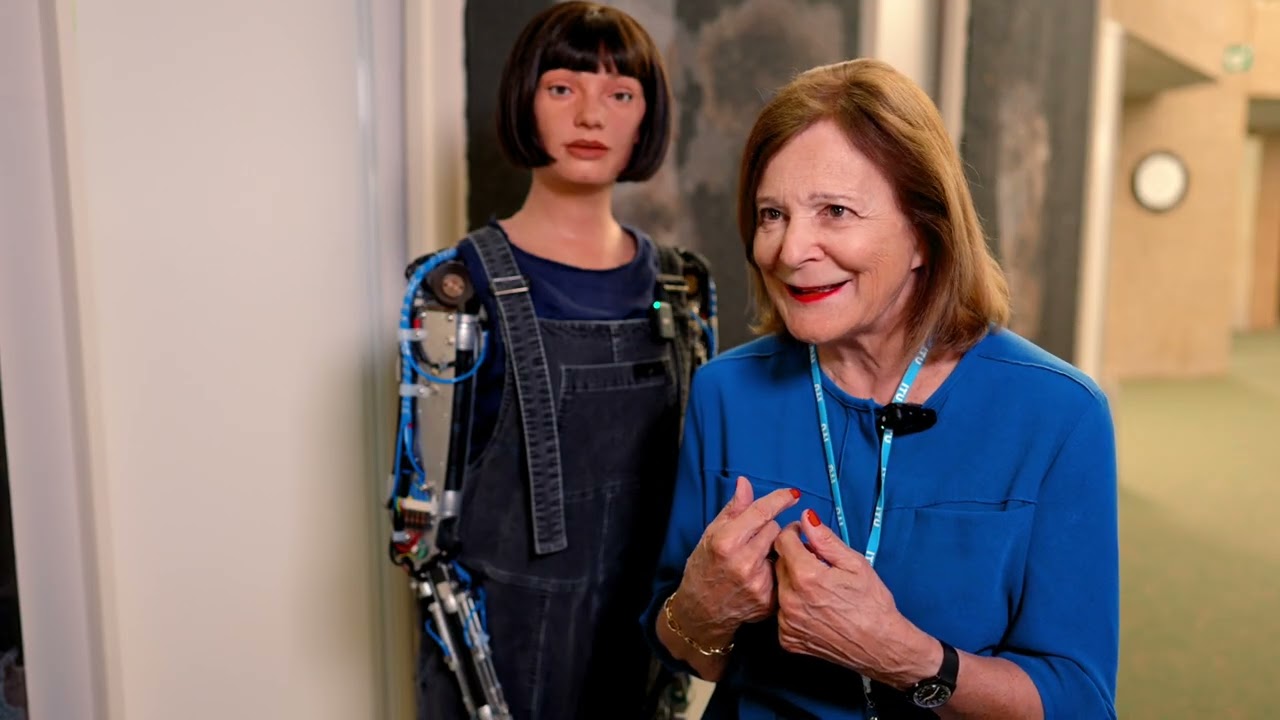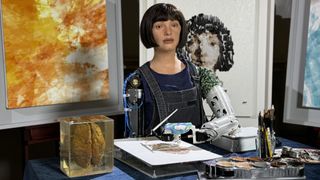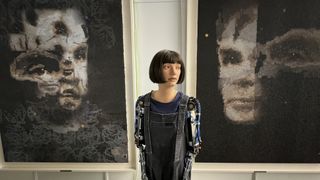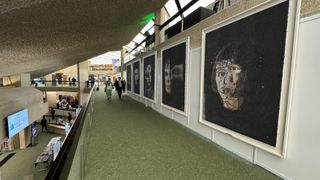Why You’re Wrong About AI Art, According to the Ai-Da Robot That Just Created a $1 Million Painting
Science fiction promised us robot butlers, but it seems they prefer to think of themselves as artists. And who can blame them? On November 7, a painting by mathematician Alan Turing, created by an AI-powered robot called Ai-Da, sold at auction for a whopping $1,084,000 (about £865,000). That’s a more attractive lifestyle than having to sprint around a Boston Dynamics assault course.
The auction house Sotheby’s said Ai-Da is “the first humanoid robot artist to have a work of art sold at auction.” It also probably set the record for the most online grumbling about a painting, which is understandable – after all, shouldn’t robots be sweeping and making tea while we artfully dab the canvases?
Naturally, the Ai-Da robot and its creator Aidan Meller disagree that art should be shielded by humans. Like Marvin van The hitchhiker’s guide to the Milky Way once noted: “Here I am, with a brain the size of a planet, and they’re asking me to take you to the bridge. You call that job satisfaction? Because I don’t.”
But instead of relying on Douglas Adams to fill in the blanks, we asked Ai-Da and Meller what they would say to those skeptical of AI-generated art – and what the historic painting ‘AI God’ means for the future of creativity…
The newest ‘non-artist’
Ai-Da herself usually prefers to let her art speak for itself. When we asked her why she paints, her response was: “The main value of my work lies in its ability to serve as a catalyst for dialogue about emerging technologies.”
Fortunately, her creator Aidan Meller, a gallery owner and art world veteran, was clearer about why team Ai-Da doesn’t think the painting or her work should be considered a threat to human artists.

“Contemporary art has always provoked discussions about what art is and Ai-Da and her work are no different,” says Meller. “Its very existence is quite controversial for the art world,” he added. Considering the reaction to the painting ‘AI God’, her presence is also quite controversial for amateur artists.
Meller prefers to see Ai-Da as the natural successor to the artistic disruptors of the past. “History is littered with artists who society called ‘non-artists’. Everyone from Picasso to Matisse challenged people’s idea of what art was in their time. Because it didn’t fit their understanding of what art should be,” he told us. .
“Duchamp challenged the idea of what art could be by placing a urinal in an art gallery and changed the future of art. The Ai-Da Robot challenges the idea of what an artist can be, by creating art using of AI technology and creative assets,” he added.
But how exactly is AI art created, in the case of Ai-Da, and are humanoid robots a necessary part of it that gains mainstream acceptance? After all, there’s a difference between clicking the ‘create’ button in the best AI art generators and watching a robot physically apply strokes to a canvas.
Who really holds the brush?
In reality, Ai-Da’s work is a collaboration between AI, robots and humans, with the latter still a very necessary part of the process. “We had a conversation with Ai-Da about what she could paint in relation to the concept of ‘AI for Good,’ and she came up with Alan Turing,” Meller explained.
“We then showed Ai-Da Robot an image of Alan Turning, to which Ai-Da responded by creating the artwork. She painted 15 images of Alan Turing and then selected three to combine together to form AI God,” added he added.

Those three portraits were uploaded to a computer and then printed onto a canvas, with Ai-Da then adding marks and textures to complete the painting. Some final bits of texture were added by human assistants in the parts of the canvas that Ai-Da couldn’t reach.
The finished artwork thus has more in common with Warhol’s ‘Factory’ process than with a decade-long Da Vinci masterpiece. But what does this all mean for the future of art?
The $1 million question
The creator of Ai-Da is certainly not on the side of AI cynics like Linux founder Linus Torvalds, who recently decried AI as “90% marketing and 10% reality.”
“I think the response to the painting at the auction shows that people understand the importance and power of AI in the way it shapes the world we live in and our entire future,” said Aidan Meller. “The auction shows that AI is on the rise and will change society enormously.”
The painting’s historic price tag, which shattered its pre-auction estimate of around $120,000-$180,000 (£100,00-£150,000), suggests that something has also changed in art collecting.
“I think it also means that the art world is starting to accept that AI art is here to stay. It also shows that creativity comes in many forms and that AI has the ability to be creative and add value to the world. ” Meller added.

That last point remains up for debate and will remain so indefinitely. For example, the makers of the popular digital art app Procreate recently said that they will never embrace generative AI. In fact, they went a little harder, with CEO James Cuda saying, “I really hate generative AI. I don’t like what’s happening in the industry and I don’t like what it’s doing to artists.” .”
It’s clear that Ai-Da and its process are just a few steps beyond the basic generative AI we see in consumer apps, but winning over skeptics could be an uphill battle. On the other hand, Ai-Da’s creator says the robot’s goal is to stimulate debate rather than convince you to switch sides…
The ‘fourth industrial revolution’
For many, Ai-Da herself is the art story rather than the $1 million painting she co-created. Meller repeated this when we asked him why Ai-Da was founded in the first place.
“Ai-Da’s main value as a robot artist lies not necessarily in acceptance, but in its ability to serve as a catalyst for dialogue on emerging technologies,” he said. Clearly the art world thinks the results of the project have monetary value, but Meller thinks it goes beyond that.

“One purpose of contemporary art is to question our times and challenge the status quo, creating debate,” he said. “So art created by an AI-powered robot was a good platform to engage the public in a discussion about the ethical issues surrounding the development of AI technology and our response as a society.”
Ai-Da herself isn’t new – we first reviewed the portrait artist in 2019 – but the rapid development of AI models has helped transform her skills and made her the face of a hot debate that sparks controversy every week. And Meller admits that, as an established artist, Ai-Da is a channel for debate.
“We are currently experiencing the Fourth Industrial Revolution, and this is resulting in extreme shifts in both technology and human behavior worldwide,” he said. “So the heart of the project is a robot artist who investigates the impact that new technologies have on society.”
Art versus navigation systems
The core of the Ai-Da debate revolves around the question of whether there is anything unique, even sacred, about art.
For many, art is a communication between people – the creator and the audience – giving AI-powered art a hollow air of meaninglessness. But Meller disagrees and sees Ai-Da’s approach as the latest development in the way people use technology.

“A lot of people look at Ai-Da and think she’s an AI-powered robot, but in many ways people are becoming more robotic in our use of technology,” he said. “We are transferring our decision-making and our agency to machines, and in many ways we are merging as humans with machines and becoming cyborgs ourselves,” he noted, pointing to smartphones as an obvious example.
“When the navigation system came out we didn’t quite trust it, but now we wouldn’t go anywhere without it. AI has infiltrated every part of our lives, from what work we are going to do, what news we watch, what kind of partner we have, what kind of baby we would even like to have,” he added. “By painting this picture of Alan Turing, Ai-Da Robot really delves into all these big ethical issues.”
We’ve been here before
While some may baulk at parallels being drawn between navigation systems and paintings, there is no doubt that Ai-Da has managed to revive a debate as old as that of art itself.
The obvious example is the invention of photography in the mid-19th century, which shocked painters who rejected the mechanized “imitation” of their painterly hand as an art form.
Ultimately, photography and art learned not only to coexist, but to develop a symbiotic relationship. French painter Degas was influenced by photography, but harbored a disdain for the commercialized industry it became. While ‘pictorialist’ photographers tried to imitate traditional watercolours, painters moved towards impressionism.

Will AI-driven art and human artists do the same, instead of trying to extinguish each other? History would suggest this. Whatever the financial or artistic merits of the ‘AI God’ painting, it’s certainly a lightning rod for debate – and whatever side of the debate you’re on, it’s worth delving into.
As the Hungarian artist Laszlo Moholy-Nagy said in the early 20th century: “Anyone who does not understand photography will be one of the illiterates of the future.” AI-powered art is clearly here to stay, and while we’ll eventually get our robot butlers, it’ll probably be worth hanging out with their artistic cousins in the meantime.
